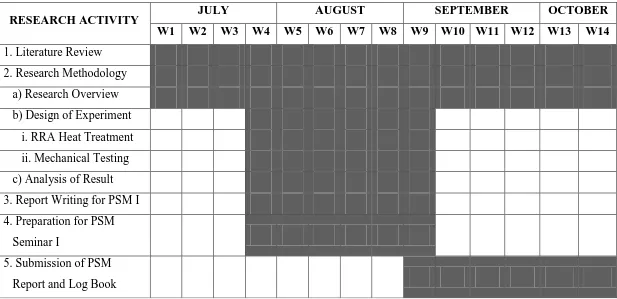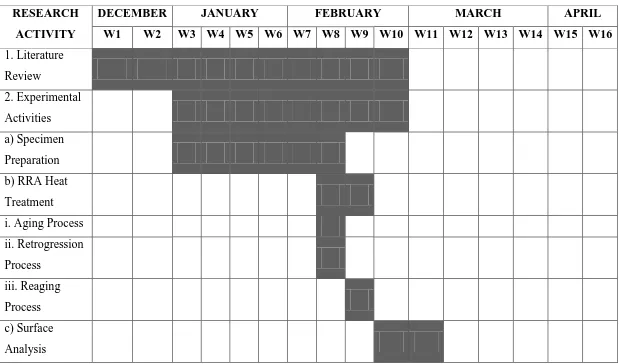ii
RETROGRESSION AND REAGING (RRA) HEAT TREATMENT PROCESS AND THE EFFECT ON MICROSTRUCTURE AND MECHANICAL PROPERTIES OF
ALUMINIUM ALLOY 7075
MOHD NAZIZI BIN SUNGIP
This report is submitted in partial fulfillment of requirement for Bachelor in Mechanical Engineering (Structure & Material)
Fakulti Kejuruteraan Mekanikal (FKM) Universiti Teknikal Malaysia Melaka (UTeM)
iii
“I have read this literary work and that in my opinion it is fully adequate, in scope and quality, as a masterpiece for the degree of
Bachelor of Mechanical Engineering (Structure & Material)”
Signature : _____________________________________ Supervisor Name : MRS SITI HAJAR BT SHEIKH MD FADZULLAH
iv
“I hereby declare that all information in this document has been obtained and presented accordance with academic rules and ethical conduct. I have fully cited and referenced all
materials and results that are not original to this work”
Signature : _______________________
Name : MOHD NAZIZI B SUNGIP
v
vi
ACKNOWLEDGEMENT
It is a pleasure for me to thank especially to those who are commit in lending their hands towards this report. First of all, I would like to give credits to Mrs. Siti Hajar who is willing to supervise me along the completion of this PSM. She also helps me a lot in showing the guidance to complete this report and solving the problems occurred at the middle of this project as well.
Besides, my thankful also to my partner, Nurul Azreen, who has contributed a lot in helping me for searching the information to be used in writing this report.
I would like to express my gratitude also to those technicians who are contributed in preparing the specimen and conducting experiments and tests as well. My credits to Mr. Mahathir, Mr. Mazlan, Mr. Razmi, Mr. Rizal, Mr. Sahar, Mr Hairi and Mr. Fauzi for the helps.
vii
ABSTRACT
viii
ABSTRAK
ix
TABLE OF CONTENT
CHAPTER TITLE PAGE
AVOWAL iii
DEDICATION v
ACKNOWLEDGEMENT vi
ABSTRACT vii
ABSTRAK viii
TABLE OF CONTENT ix
LIST OF TABLES xii
LIST OF FIGURES xiv
LIST OF SYMBOL xvii
LIST OF APPENDICES xviii
CHAPTER 1 INTRODUCTION 1
1.1 Overview 1
1.2 Problem Statement 2
1.3 Objective 2
1.4 Scope 2
1.5 Planning and Execution 3
CHAPTER 2 LITERATURE REVIEW 7
2.1 Aluminium Alloys 7
2.1.1 Types of Aluminum Alloy 8
2.1.2 Aluminum Alloy Designation 10
2.1.3 Mechanical and Chemical Properties of
x
CHAPTER TITLE PAGE
2.1.4 Advantages of Aluminium Alloy 13
2.2 Aluminium Alloy 7075 14
2.2.1 Process of Aluminium Alloy 7075 14 2.2.2 Mechanical Properties of Aluminum Alloy 7075 15
2.3 Heat Treatment 16
2.4 Retrogression and Reaging (RRA) Heat Treatment 16
2.4.1 Retrogression Process 17
2.4.2 Reaging Process 17
2.4.3 Previous Trends Produced with the RRA Heat
Treatment 18
2.4.4 Microstructural Trends in RRA Heat Treatment 20
2.5 Mechanical Testing 20
2.5.1 Effect of RRA Hear Treatment on Mechanical
Testing 22
2.6 Past Literature 24
CHAPTER 3 METHODOLOGY 28
3.1 Introduction 28
3.2 Equipment & Task 29
3.3 Specimen Preparation 30
xi
CHAPTER TITLE PAGE
3.3.2 V-Notch 31
3.4 Retrogression and Reaging (RRA) Heat Treatment
Process 32
3.4.1 T6 Condition 35
3.4.2 RRA Heat Treatment Process 36
3.4.3 T73 Condition 37
3.5 Mechanical Testing 37
3.5.1 Charpy Impact Test 37
3.5.2 Rockwell Hardness Test 38
3.6 Microstructure Characterization 39
3.6.1 Microstructure Observation 39
CHAPTER 4 RESULTS & DISCUSSION 42
4.1 Introduction 42
4.2 Hardness Test Result 42
4.3 Impact Test Result 47
4.3 Microstructure Characterization 50
CHAPTER 5 CONCLUSION 54
CHAPTER 6 RECOMMENDATION 56
REFERENCES 57
BIBLIOGRAPHY 61
xii
LIST OF TABLES
NO. TITLE PAGE
1.1 Planning and Execution for PSM I 4
1.2 Planning and Execution for PSM II 5
2.1 Wrought Alloy Series and Major Alloying Element
(Source: http://ourworld.cs.com) 9
2.2 Cast Alloy Series and Major Alloying Element
(Source: http://ourworld.cs.com) 10
2.3 Aluminium Chemical Composition
(Source: http://ourworld.cs.com) 12
2.4 Mechanical Properties of Aluminium Alloy
(Source: http://ourworld.cs.com) 12
2.5 Mechanical Properties of Aluminium Alloy 7075-T6
(Source: http://asm.matweb.com) 15
3.1 Equipments and Tasks 30
xiii
NO TITLE PAGE
4.1 Hardness Test Results 43
xiv
LIST OF FIGURES
NO. TITLE PAGE
2.1 Yield Strength versus Retrogression Time
(Source: Charles P.F. (2001)) 19
2.2
Relationship between Strength and Stress Corrosion
Resistance (SCC) during Aging of High Strength, 7000 Series Alloy.
(Source: Charles P.F. (2001))
22
2.3
Plot of 0.2% Yield Strength versus Crack Growth Rates for T6, T73, and Various RRA Temper
(Source: Charles P.F. (2001))
23
2.4
Plot of Hardness versus Crack Growth Rates for T6, T73 and Various RRA Tempers
(Source: Charles P.F. (2001))
23
2.5 Yield Strength versus Retrogression Time
(Source: Charles P.F. (2001)) 25
xv
NO TITLE PAGE
3.2 Specimen Dimensions 31
3.3 V-Notch Angle 31
3.4 Front View, Side View, Top View & Isometric View of
Specimen 31
3.5 Process Flow 32
3.6 Specimens in the Furnace 36
3.7 Quenching Process 36
3.8 Charpy Impact Test 37
3.9 Placement of Specimen 37
3.10 Placement of Specimen of Hardness Test 39
3.11 Manual Polishing Machine 40
3.12 Grinding Machine 40
3.13 Electronic Bath Machine 40
xvi
NO TITLE PAGE
4.1
Variation in Rockwell Hardness (B scale) as a Function of Retrogression Time of Samples Subjected to Retrogression and RRA Treatments
44
4.2 Variation in Rockwell Hardness (B scale) as a Function of
Different Treatments 45
4.3
Variation in Impact Energy as a Function of Retrogression Time of Samples Subjected to Retrogression and RRA Treatments
48
4.4 Variation in Impact Energy as a Function of Different
Treatments 49
4.5 Microstructure of T6 Temper 50
4.6 Microstructure of T73 Temper
(Magnification 100x) 50
4.7 Microstructure of RRA at 5 Minutes Retrogression Time
(Magnification 100x) 52
4.8 Microstructure of RRA at 10 Minutes Retrogression Time
(Magnification 100x) 52
4.9 Microstructure of RRA at 20 minutes Retrogression Time
xvii
LIST OF SYMBOL
Cu = Copper
Mn = Manganese
Mg = Mangnesium
Si = Silicon
Cr = Cromat
Zn = Zinc
F = Fahrenheit
ºC = Degree Celsius
= average length
ASTM = American Society Testing Material
Kg = kilogram
Mpa = mega Pascal
kPa = kilopascal
wt = weight
h = hour
mm = millimetre
= nucleation site
= equilibrium precipitate
GP = Guiner Preston
HRB = Hardness Rockwell (Scale B)
kJ = kilo Joule
xviii
LIST OF APPENDICES
NO TITLE PAGE
A ASTM E 23 REV A Standard Test Methods for Notched Bar
Impact Testing of Metallic Materials 62
B ASTM D785, ISO 2039 63
C Universal Impact Tester 65
1
CHAPTER 1
INTRODUCTION
1.1 Overview
Aluminum is a silverish white metal that has a strong resistance to corrosion and like gold, is rather malleable. It is a relatively light metal compared to metals such as steel, nickel, brass, and copper with a specific gravity of 2.7. Aluminum is easily machinable and can have a wide variety of surface finishes. It also has good electrical and thermal conductivities and is highly reflective to heat and light. Aluminum alloys are lightweight and strong, but do not possess the corrosion resistance of pure aluminum. Pure aluminum is too soft for most structural applications and therefore is usually alloyed with several elements to improve its corrosion resistance and of course to increase the strength.
2 1.2 Problem Statement
Retrogression and reaging heat treatment (RRA) is a treatment process of changing the mechanical properties, the metallurgical structure of a metal product. In aluminum alloy, it is frequently used to increase strength and hardness of the precipitation hardenable alloys.
In the previous studies of RRA shows that RRA are capable of producing a material with mechanical and stress corrosion strengths at higher temperature. This study is carried out to study whether RRA at lower temperature ranges produces the same positive effect on the mechanical properties of aluminum alloy.
1.3 Objective
The objectives of this project are:
(a) To study the retrogression and heat treatment process at lower temperature range.
(b) To study the effect on microstructure and mechanical properties of aluminum alloy 7075.
1.4 Scope
The scopes of this project are:
(a) To carry out RRA heat treatment process for aluminum alloy 7075.
3 (c) To study the microstructures characterization of the RRA heat treatment aluminum
alloy 7075 followed by mechanical testing.
1.5 Planning and Execution
4
Table 1.1: Planning and Execution for PSM I
RESEARCH ACTIVITY JULY AUGUST SEPTEMBER OCTOBER
W1 W2 W3 W4 W5 W6 W7 W8 W9 W10 W11 W12 W13 W14
1. Literature Review 2. Research Methodology a) Research Overview b) Design of Experiment i. RRA Heat Treatment ii. Mechanical Testing c) Analysis of Result 3. Report Writing for PSM I 4. Preparation for PSM
Seminar I
5
Table 1.2: Planning and Execution for PSM II RESEARCH
ACTIVITY
DECEMBER JANUARY FEBRUARY MARCH APRIL
W1 W2 W3 W4 W5 W6 W7 W8 W9 W10 W11 W12 W13 W14 W15 W16
1. Literature Review
2. Experimental Activities a) Specimen Preparation b) RRA Heat Treatment i. Aging Process ii. Retrogression Process
6 d) Mechanical
Testing
i. Hardness Test ii. Impact Test 3. Result Analysis 4. Report
Writing for PSM II
7
CHAPTER 2
LITERATURE REVIEW
This chapter will discuss more detail about all key components related to this topic such as aluminum alloy, aluminum 7075, retrogression and reaging (RRA) heat treatment, hardness test, impact test and microstructure characterization.

